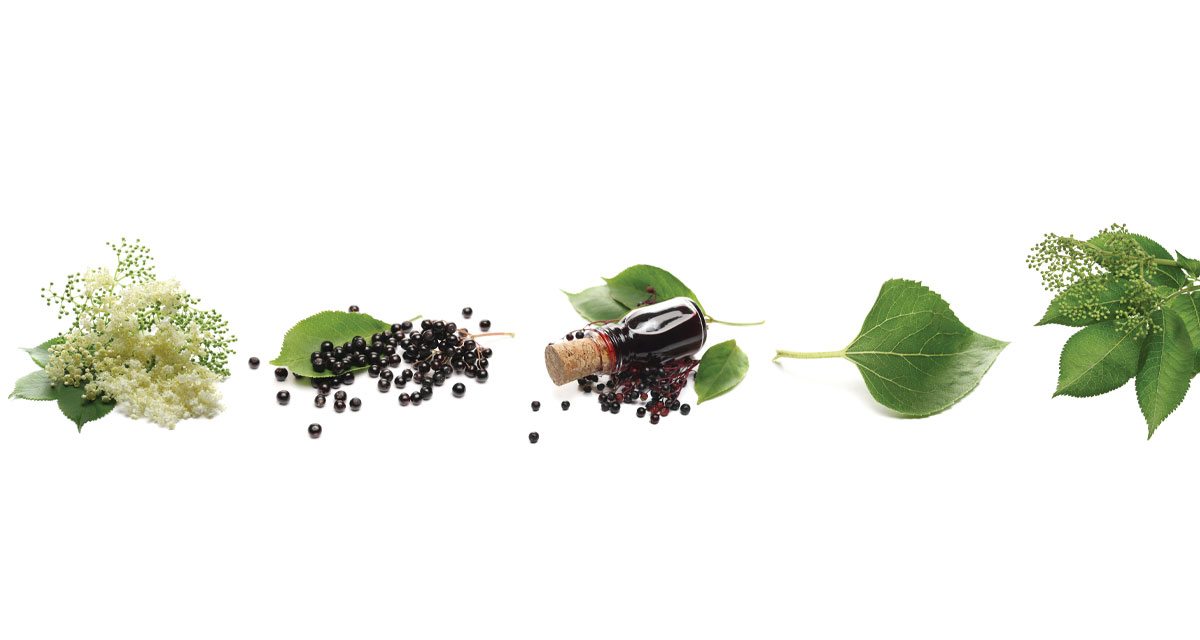The Hippocratic Oath remains a promise of safe healing from a man whom legend defines as the demi-god of medicine, the son of Apollo himself, the god of healing and the sun. Since his handwritten journals have survived, we know that Hippocrates believed that “our natural aptitude is the soil; the instruction our teachers give us is in the seeds. Our basic education is the planting of the seeds at the right time…. Commitment and time ensure strong growth.” As a staunch proponent of medicinal herbs, he compared the elder tree to nature’s medicine chest and kept the berries readily available during his travels in villages. Since 400 BC, our love of elderberry has grown stronger.
What is Black Elderberry?
Growing along the roadside, at farms, and in bee gardens, is a shrub with enlarged, beautiful white floral blossoms, which transition to bluish-purple medicinal berries in late summer. Sambucus nigra is one of the species in the Adoxaceae family, known by the common names of elder tree, elderberry, black elder, black lace, blue elderberry, and the list continues. One distinguishing quality is that the stems leading to the fruit are purple. Discovering a plant is exhilarating; however, do not eat them raw; they are poisonous.
Propagation Tip: Between December and February, use clean, sharp clippers to cut six-inch “sips.” Remove leaves near the bottom of the stem and place in a glass of water near a sunny window. After four to six weeks, transfer the young plant to soil. Always remember, elderberries love water; so, water deeply. Planting can occur as early as April. Use a three-gallon bucket to protect them from freezing temperatures or frost.
Berry Benefits
Flavonoids, with high levels of Anthocyanin, provide a distinctive water-soluble pigment that may appear blue, purple, or black, and which offer an additional boon to good health—natural antioxidant properties. Elderberry is a tasty ingredient found in foods, drinks, skin care products, medicines, and supplements.
Flower Benefits
Between the cluster of five dark green leaves lies the elderflower. Before flowering, the buds grow larger until they blossom out of the stem. While the berry itself has extraordinary medicinal powers, the flowers possess antiseptic and anti-inflammatory properties to treat, among other conditions, colds, sinus infections, and respiratory disturbances.
The health benefits:
- Elderflowers reduce congestion, runny nose, and the ills and chills associated with allergies and a cold;
- They are used as a treatment to prevent bleeding;
- They alleviate swelling in the joints and lower arthritic pain levels;
- They can lower blood sugar levels;
- Elderflowers boost the functioning of the immune system, and eliminate bacterial pathogens;
- They can calm itchy eyes due to pollen or dust.
The elderflower is safe for consumption, but requires drying. Consider it an ingredient as a tea, tisane, tincture, poultice, or made with beeswax to create a unique balm or salve.
Fact: Native Americans used the branches of Black Elderberry to make flutes and deemed it, “The Tree of Music.”
Recipes
From baked apples with elderberry syrup served with ice cream to cran-elderberry relish—ideal for a Thanksgiving meal—any recipe including Sambucus nigra will include a tasty and immune-supportive benefit.
Elderberry Syrup: The two most essential ingredients are elderberries, either fresh or dried, and raw honey. Once the berries, clove, cinnamon stick, and vanilla bean are cooked, well-infused and mashed, strain. For medicinal syrup, add an equal proportion of honey to water and consume one teaspoon morning and night. Thicker syrups for teas and pancakes, for instance, require a 75% addition of honey. Homemade syrups will last approximately one year if kept in a cool, dark location.
Elderberry Cherry Freeze Pops: As hydration is critical in summer or avoided in the winter, try the following recipe to ensure a boost of good nutrients and health.
Directions: In a large bowl, mix 1.5 cups of water, 1 cup of tart cherry juice, a half-cup of elderberry syrup, and a splash of lemon juice; then pour the mixture into an ice cube tray, cover with plastic wrap, and poke a toothpick through to the middle of each mold. Wait 12 hours before serving!
The world of elderberries is available to you, especially since the season is perfect for hand-picking; however, you’ll find it difficult to choose just one recipe!























